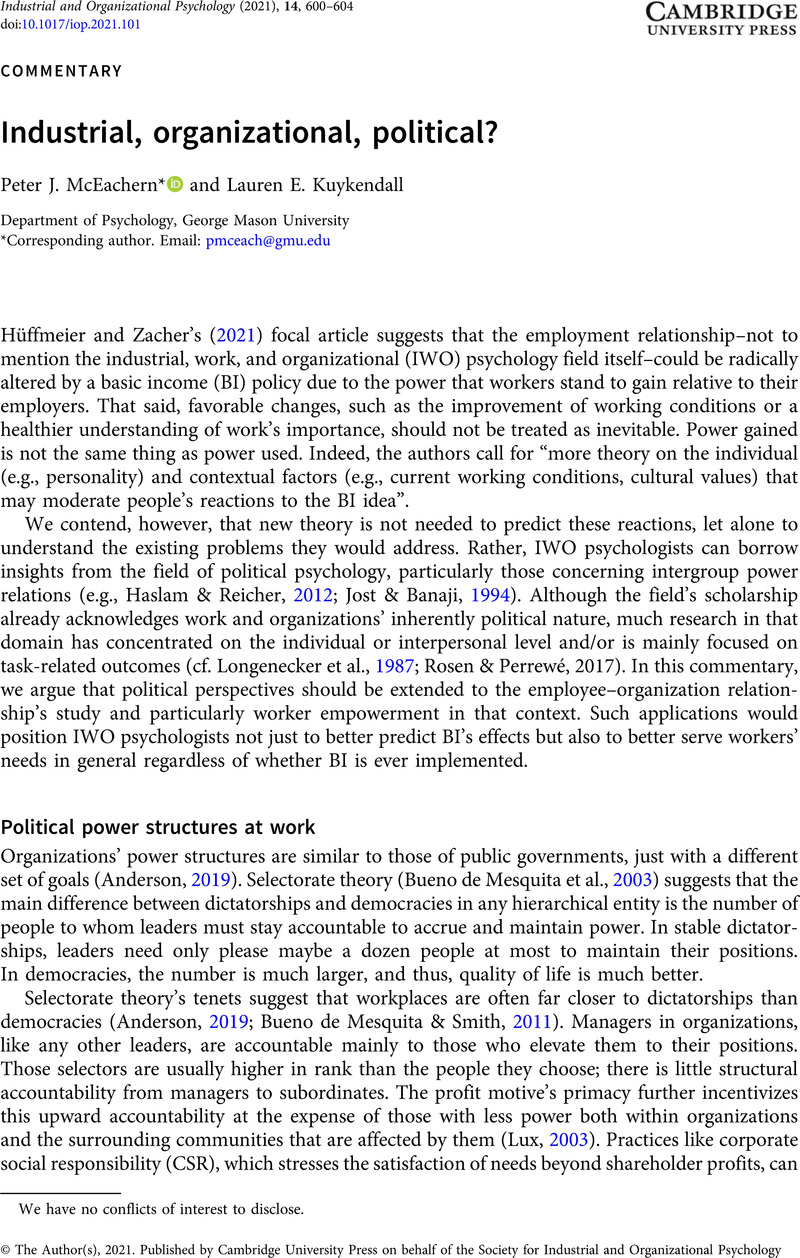No CrossRef data available.
Article contents
Industrial, organizational, political?
Published online by Cambridge University Press: 14 December 2021
Abstract
An abstract is not available for this content so a preview has been provided. Please use the Get access link above for information on how to access this content.

- Type
- Commentaries
- Information
- Copyright
- © The Author(s), 2021. Published by Cambridge University Press on behalf of the Society for Industrial and Organizational Psychology
Footnotes
We have no conflicts of interest to disclose.
References
Bueno de Mesquita, B., & Smith, A. (2011). The dictator’s handbook: Why bad behavior is almost always good politics. PublicAffairs.Google Scholar
Bueno de Mesquita, B., Smith, A., Siverson, R. M., Morrow, J. D., & de Mesquita, B. B. (2003). The logic of political survival. MIT Press.CrossRefGoogle Scholar
Communication Workers of America. (n.d.). Common bluffs. Union Busting Playbook. https://unionbustingplaybook.com/#common-bluffs
Google Scholar
Cooper, D., & Mishel, L. (2015). The erosion of collective bargaining has widened the gap between productivity and pay. Economic Policy Institute. https://www.goiam.org/wp-content/uploads/2014/06/images_articles_news_economic-trends_productivitypay.pdf
Google Scholar
Evans, B., & Reid, J. (2013). Dangerously exposed: The life and death of the resilient subject. Resilience, 1(2), 83–98. https://doi.org/10.1080/21693293.2013.770703
CrossRefGoogle Scholar
Felicetti, A. (2018). A deliberative case for democracy in firms. Journal of Business Ethics, 150(3), 803–814. https://doi.org/10.1007/s10551-016-3212-9
CrossRefGoogle Scholar
Fiske, S. T. (2018). Social beings: Core motives in social psychology. John Wiley & Sons.Google Scholar
Haslam, S. A., & Reicher, S. D. (2012). When prisoners take over the prison: A social psychology of resistance. Personality and Social Psychology Review, 16(2), 154–179. https://doi.org/10.1177/1088868311419864
CrossRefGoogle ScholarPubMed
Hennekam, S., Ladge, J., & Shymko, Y. (2020). From zero to hero: An exploratory study examining sudden hero status among nonphysician health care workers during the COVID-19 pandemic. Journal of Applied Psychology, 105(10), 1088–1100. https://doi.org/10.1037/apl0000832
CrossRefGoogle ScholarPubMed
Hüffmeier, J., & Zacher, H. (2021). The basic income: Initiating the needed discussion in industrial, work, and organizational psychology. Industrial and Organizational Psychology: Perspectives on Science and Practice, 14(4), 531–562.Google Scholar
Jost, J. T., & Banaji, M. R. (1994). The role of stereotyping in system-justification and the production of false consciousness. British Journal of Social Psychology, 33, 1–27. https://doi.org/10.1111/j.2044-8309.1994.tb01008.x
CrossRefGoogle Scholar
Jost, J., & Hunyady, O. (2002). The psychology of system justification and the palliative function of ideology. European Review of Social Psychology, 13(1), 111–153. https://doi.org/10.1080/10463280240000046
CrossRefGoogle Scholar
Kay, A. C., Jost, J. T., & Young, S. (2005). Victim derogation and victim enhancement as alternate routes to system justification. Psychological Science, 16(3), 240–246. https://doi.org/10.1111/j.0956-7976.2005.00810.x
CrossRefGoogle ScholarPubMed
Kärreman, D., & Alvesson, M. (2004). Cages in tandem: Management control, social identity, and identification in a knowledge-intensive firm. Organization, 11(1), 149–175. https://doi.org/10.1177/1350508404039662
CrossRefGoogle Scholar
Kelloway, E. K., & Barling, J. (1993). Members’ participation in local union activities: Measurement, prediction, and replication. Journal of Applied Psychology, 78(2), 262–279. https://doi.org/10.1037/0021-9010.78.2.262
CrossRefGoogle Scholar
Kollmeyer, C. (2018). Trade union decline, deindustrialization, and rising income inequality in the United States, 1947 to 2015. Research in Social Stratification and Mobility, 57, 1–10. https://doi.org/10.1016/j.rssm.2018.07.002
CrossRefGoogle Scholar
Lefkowitz, J. (2009). Promoting employee justice: It’s even worse than that. Industrial and Organizational Psychology, 2(2), 221–225. https://doi.org/10.1111/j.1754-9434.2009.01138.x
CrossRefGoogle Scholar
Lepie, J. (2016). The union-buster’s toolkit. Employee Responsibilities and Rights Journal, 28(4), 249–264. https://doi.org/10.1007/s10672-016-9283-z
CrossRefGoogle Scholar
Logan, J. (2006). The union avoidance industry in the United States. British Journal of Industrial Relations, 44(4), 651–675. https://doi.org/10.1111/j.1467-8543.2006.00518.x
CrossRefGoogle Scholar
Longenecker, C. O., Sims, H. P. Jr., & Gioia, D. A. (1987). Behind the mask: The politics of employee appraisal. Academy of Management Perspectives, 1(3), 183–193. https://doi.org/10.5465/ame.1987.4275731
CrossRefGoogle Scholar
Lux, K. (2003). The failure of the profit motive. Ecological Economics, 44(1), 1–9. https://doi.org/10.1016/S0921-8009(02)00270-7
CrossRefGoogle Scholar
Manjoo, F. (2020, July 15). Please don’t call them heroes. New York Times. https://www.nytimes.com/2020/07/15/opinion/schools-reopening.html
Google Scholar
Markussen, S., & Røed, K. (2020). Economic mobility under pressure. Journal of the European Economic Association, 18(4), 1844–1885. https://doi.org/10.1093/jeea/jvz044
CrossRefGoogle Scholar
Mellor, S. (2016). Adulthood social class and union interest: A first test of a theoretical model. Journal of Psychology, 150(7), 849–865. https://doi.org/10.1080/00223980.2016.1203278
CrossRefGoogle ScholarPubMed
Murolo, P., & Chitty, A. B. (2012). From the folks who brought you the weekend: A short, illustrated history of labor in the United States. The New Press.Google Scholar
Orlitzky, M., Schmidt, F. L., & Rynes, S. L. (2003). Corporate social and financial performance: A meta-analysis. Organization Studies, 24(3), 403–441. https://doi.org/10.1177/0170840603024003910
CrossRefGoogle Scholar
Pratt, M., Pradies, C., & Lepisto, D. A. (2013). Doing well, doing good and doing with: Organizational practices for effectively cultivating meaningful work. In Dik, Bryan J., Byrne, Zinta S., & Steger, Michael F. (Eds.), Purpose and meaning in the workplace (Chapter 8). American Psychological Association.Google Scholar
Rosen, C. C., & Perrewé, P. L. (Eds.). (2017). Power, politics, and political skill in job stress. Emerald Group Publishing.CrossRefGoogle Scholar
Sandel, M. J. (2020). The tyranny of merit: What’s become of the common good? Macmillan.Google Scholar
Sainato, M. (2020, September 24). Walmart cuts workers’ hours but increases workload as sales rise amid pandemic. Guardian. https://www.theguardian.com/business/2020/sep/24/walmart-workers-hours-pay-great-workplace
Google Scholar
Shymko, Y., & Frémeaux, S. (in press). Escaping the fantasy land of freedom in organizations: The contribution of Hannah Arendt. Journal of Business Ethics. https://doi.org/10.1007/s10551-020-04707-x
CrossRefGoogle Scholar
Strategic Organizing Center (2021, May). Primed for pain: Amazon’s epidemic of workplace injuries. Strategic Organizing Center. https://thesoc.org/wp-content/uploads/2021/02/PrimedForPain.pdf
Google Scholar
Tetrick, L. E., Shore, L. M., McClurg, L. N., & Vandenberg, R. J. (2007). A model of union participation: The impact of perceived union support, union instrumentality, and union loyalty. Journal of Applied Psychology, 92(3), 820–828. https://doi.org/10.1037/0021-9010.92.3.820
CrossRefGoogle Scholar
Wakeham, J. (2017). Bullshit as a problem of social epistemology. Sociological Theory, 35(1), 15–38. https://doi.org/10.1177/0735275117692835
CrossRefGoogle Scholar
Weber, W. G., Unterrainer, C., & Höge, T. (2020). Psychological research on organisational democracy: A meta-analysis of individual, organisational, and societ al outcomes. Applied Psychology, 69(3), 1009–1071. https://doi.org/10.1111/apps.12205
CrossRefGoogle Scholar
Zickar, M. J. (2001). Using personality inventories to identify thugs and agitators: Applied psychology’s contribution to the war against labor. Journal of Vocational Behavior, 59(1), 149–164. https://doi.org/10.1006/jvbe.2000.1775
CrossRefGoogle Scholar
Zickar, M. J. (2004). An analysis of industrial-organizational psychology’s indifference to labor unions in the United States. Human Relations, 57(2), 145–167. https://doi.org/10.1177/0018726704042925
CrossRefGoogle Scholar


